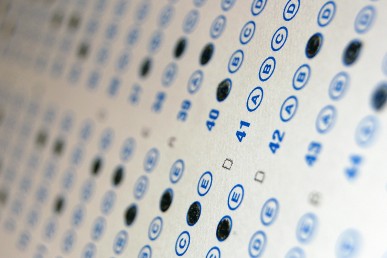New assessments needed for science learning, report says
 A new system of assessment is necessary for valid measurement of students’ proficiency under the latest science learning standards, according to a new national report co-authored by a University of Illinois at Chicago researcher.
A new system of assessment is necessary for valid measurement of students’ proficiency under the latest science learning standards, according to a new national report co-authored by a University of Illinois at Chicago researcher.
The National Research Council’s report, “Developing Assessments for the Next Generation of Science Standards,” describes the type of assessment system that should be created and offers examples of the types of tasks and questions that could better evaluate student knowledge under the soon-to-be-implemented Next Generation Science Standards.
The report, which was written by a group of learning and assessment experts co-chaired by James Pellegrino, co-director of the UIC Learning Sciences Research Institute, advises states to move from single, end-of-the-year tests to monitor student progress in science to a strategy that includes the use of a variety of assessments, such as those administered by teachers regularly throughout the academic year.
“This is a major shift in what needs to be built and implemented. No longer can we rely on a single ‘drop in from the sky,’ end-of-year standardized test to adequately measure students’ science learning,” says Pellegrino, UIC distinguished professor of psychology and education.
According to Pellegrino, current assessments tend to ask students to define the scientific method absent specific content, while the new standards emphasize depth of knowledge based on the ability to integrate core content with science and engineering practices.
“Assessments under Next Generation Science Standards should ask students to demonstrate that they understand aspects of scientific reasoning by applying particular science practices, such as designing a study or interpreting the meaning of a data set, to questions about genetic inheritance, for example,” he said.
The new standards, which have been adopted by eight states, are based on three key facets: scientific and engineering practices, core ideas of the science and engineering disciplines and “crosscutting concepts” such as cause and effect and energy and matter.
They are aimed at making science education more closely resemble the way scientists work and think, and are built on research about learning that demonstrates the importance of building coherent understandings over time.
The report calls for assessing students in the three areas using a variety of question formats that require students to supply an answer, produce a product or perform an activity.
The report states that “‘formative assessments” would help teachers see how students are progressing in order to make instructional decisions, while “monitoring assessments” would measure science learning on a broader scale.
To fully evaluate whether students are meeting expectations under Next Generation Science Standards, the committee recommends blending external assessments, such as state-mandated tests, with information from classroom-embedded assessments.
Examples of the latter include independent curriculum units that include both instructional materials and state or district assessments for the classroom, or state- or district-recommended tasks that schools and teachers would utilize at the appropriate time in accordance with the classroom instructional plan.
The report also considers designing classroom instruction, intertwined with assessment, a priority before proceeding to assessment that meets the needs for monitoring purposes, such as accountability of teachers, schools and districts.
“Our greatest danger may be a rush to turn the Next Generation Science Standards into sets of assessment tasks for use on high-stakes state accountability tests before we have insured that teachers have been given the time, support and assessment tools to create instructional environments where their students have adequate opportunities to learn what is now expected of them,” said Pellegrino, who has researched learning and assessment practices for over three decades.
The report was sponsored by the Bechtel Corp., Carnegie Corporation of New York and the William and Flora Hewlett Foundation.
